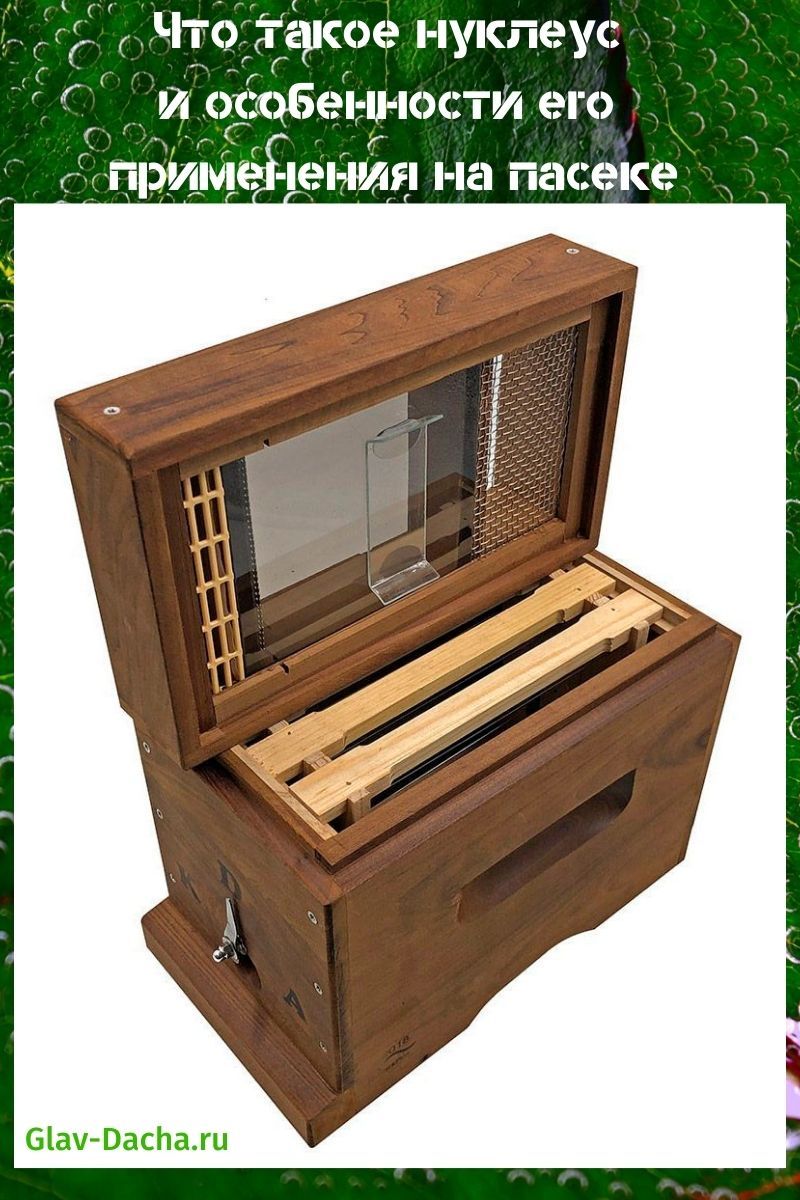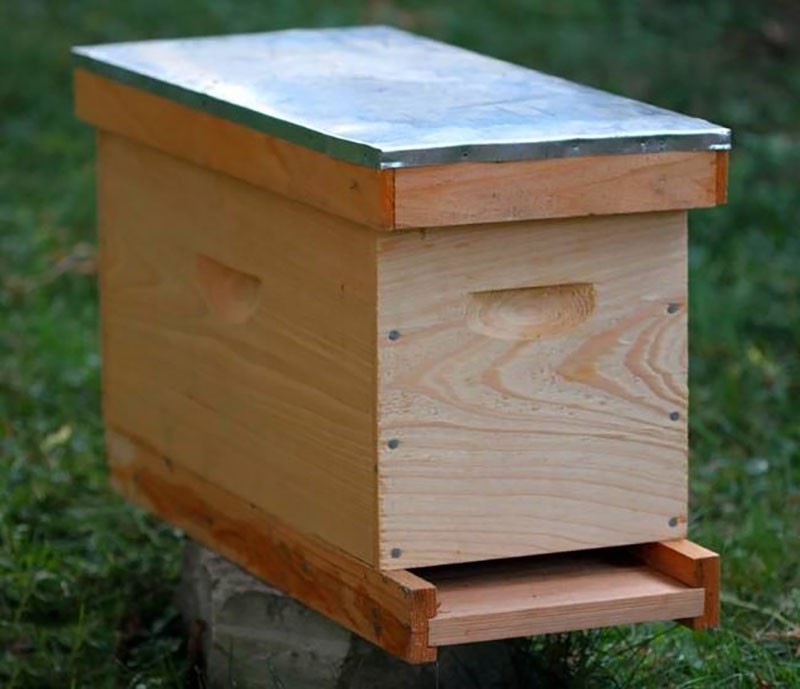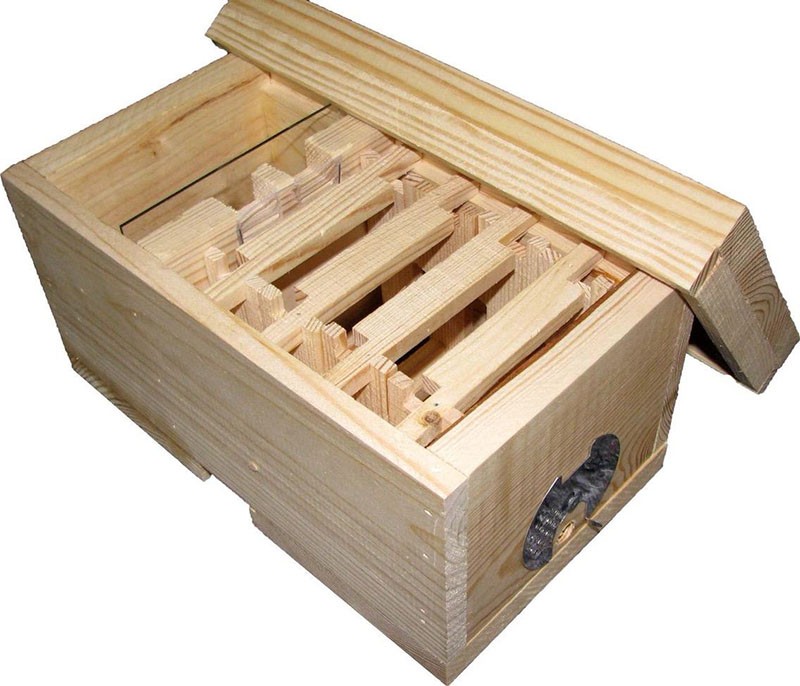What is a nucleus and features of its use in an apiary
 The nucleus is very important in beekeeping, because it is used no less often than ordinary hives. But not every novice beekeeper knows exactly what a nucleus is, what varieties exist and what it is used for in an apiary.
The nucleus is very important in beekeeping, because it is used no less often than ordinary hives. But not every novice beekeeper knows exactly what a nucleus is, what varieties exist and what it is used for in an apiary.
What is a nucleus - the main features

Nucleus hives can accommodate only one small bee colony with one fertilized or infertile queen. Typically, a bee colony for a nucleus consists of 500-1000 workers.
Such hives have several differences from the standard design.:
- The bee colony in the nucleus hive is susceptible to attacks from other insects.
- The family contains few workers who cannot provide the necessary amount of honey for the wintering of the entire bee swarm.
- Due to its characteristics and the created living conditions, the nucleus increases the viability of bees, which are forced to activate in order to survive.
 Beekeepers need to consider not only what cores are, but also how to use them correctly in an apiary.
Beekeepers need to consider not only what cores are, but also how to use them correctly in an apiary.
Purposes of using the nucleus
 Nucleus hives greatly simplify the work of beekeepers and are used in apiaries for various purposes.
Nucleus hives greatly simplify the work of beekeepers and are used in apiaries for various purposes.
Why do you need a nucleus:
- Industrial breeding of young queens and their flying around by drones.
- Fertilization of queens - in ordinary hives in large-scale apiaries, this process is unprofitable. This requires a large number of drones, which do not bring much benefit. That is why many beekeepers make a bee nucleus to get new, including fertilized queens.
- Increase in the number of workers - in the core, their number increases much faster than in full-fledged hives.
The nucleus hive makes the formation of new families easier and faster. This can be done in an ordinary hive - but in this case, constant monitoring of the bees, their condition and location is required. With the use of a core, this need disappears.
Types of cores
Nucleus hives you can buy in specialized stores for beekeepers or you can make it yourself. It does not take much time, this design is simple, so even a novice beekeeper can make it.
But before making your own nucleus, you need to familiarize yourself with its main types.:
- Mininucleus - such a construction of expanded polystyrene is most often made in 6 frames. They can be bought in shops for beekeepers, or made with your own hands - for example, a prismatic core made of polystyrene foam.

- Micronucleus - this type of hives with double bottoms are used for flying around queens. The construction itself consists of 4 uterine sites with small frames measuring no more than 75 mm.

- Multiple nucleus - used for keeping infertile queens. The dimensions of its frames are half the size of the standard frame.

A 12-seat core hive stands out separately - it is fenced with bumpers that equip tap holes. This prevents the flight of bees from one part of the structure to another.

Self-made core
 You can make a nucleus hive yourself - its design is simple, so even a novice beekeeper can handle it.
You can make a nucleus hive yourself - its design is simple, so even a novice beekeeper can handle it.
First of all, you need to prepare all the necessary materials - cores can be made from the same materials as standard designs. The most commonly used fiberboard, expanded polystyrene, foam.
Necessary materials:
- a bar made of wood to create a frame;
- Fiberboard for the manufacture of structure walls;
- a sheet of plywood to separate the hive inside;
- galvanized metal sheets for the hive cover.
All materials used must be environmentally friendly and safe for the bee colony.
Nucleus making step by step
 For the manufacture of the structure, it is necessary to prepare drawings of the nucleus hives - they must indicate the overall dimensions of the structure, mark the places for the installation of entrances, feeders and frames. Ready-made hive schemes can be found on the Internet or specialized literature.
For the manufacture of the structure, it is necessary to prepare drawings of the nucleus hives - they must indicate the overall dimensions of the structure, mark the places for the installation of entrances, feeders and frames. Ready-made hive schemes can be found on the Internet or specialized literature.
How to make a core according to instructions:
- On a sheet of expanded polystyrene, fiberboard or other material used, make markings according to the drawings. Make the cutouts according to the diagram.
- Assemble the case - fix the ends for fiberboard with nails, reinforce with self-tapping screws, for expanded polystyrene - pre-lubricate with glue and fix.
- Make holes that will be used for the entrance.
- Divide the inside of the hive with equal-sized partitions. Attach them with self-tapping screws to the side walls of the case.
- In the inner space of the box, fit fasteners for the feeder and frames.
- Make a lid. Attach a galvanized metal sheet to it - it is needed to protect the bee colony from moisture penetration into the hive. The cover can be attached to the body with hinges, or it can be removable.
- Separately cut a tap hole for each compartment. The maximum permissible hole size should be 15 mm.
- Nail the bottom to the bottom of the case. The bottom of the structure must be equipped with legs - it is most convenient to make them from four bars, attaching them to the body with self-tapping screws.
Test the finished core hive for strength. If the structure is stable, you can proceed to the final stage - painting it.
Core formation rules
 Nucleus formation is carried out from a strong, large and robust bee colony. It is best to colonize the nucleus hive at a time when insects are swarming or during the main honey gathering period. It is desirable to carry out the selection in the early morning, when most of the workers are flying around, and the hives are practically empty.
Nucleus formation is carried out from a strong, large and robust bee colony. It is best to colonize the nucleus hive at a time when insects are swarming or during the main honey gathering period. It is desirable to carry out the selection in the early morning, when most of the workers are flying around, and the hives are practically empty.
To populate the core, one feeding frame with brood and two with pergoy and honey. You will also need at least 300 worker bees. In the northern regions, it is best to take two frames with brood, honey and bee bread. In such cases, the number of workers increases to 600 bees.
To form a bee colony, a sealed brood is taken, the amount of feed is at least 2 kg.
Inside the nucleus hive, a maturing mother plant is placed. In the event that the uterus has not yet been fertilized, it must be placed in an isolated cage for 5 days. After that, a place is left in the place of feed and taken brood inside the main hive, which is filled with honeycombs with foundation.
Wintering in the neucleus

If a bee colony hibernates in a nucleus hive, several rules must be taken into account.:
- The family must gain strength for the onset of winter. For this, the uterus must be planted for the last time no later than the end of July.
- In case of early completion of honey collection, the bee colony needs additional feeding. For this purpose, sugar syrup is used - at least 300 g for each hive.
- From standard hives, you need to select three half-frames with sealed honey and rearrange them into cores.
Nucleus greatly simplifies the work of the beekeeper, helps to strengthen its own apiary and increase its productivity.Such a design can be done independently using available materials and simple drawings.